Comprehensive Guide to 99a Skate Wheels Performance
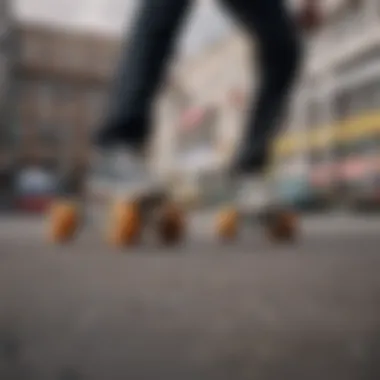
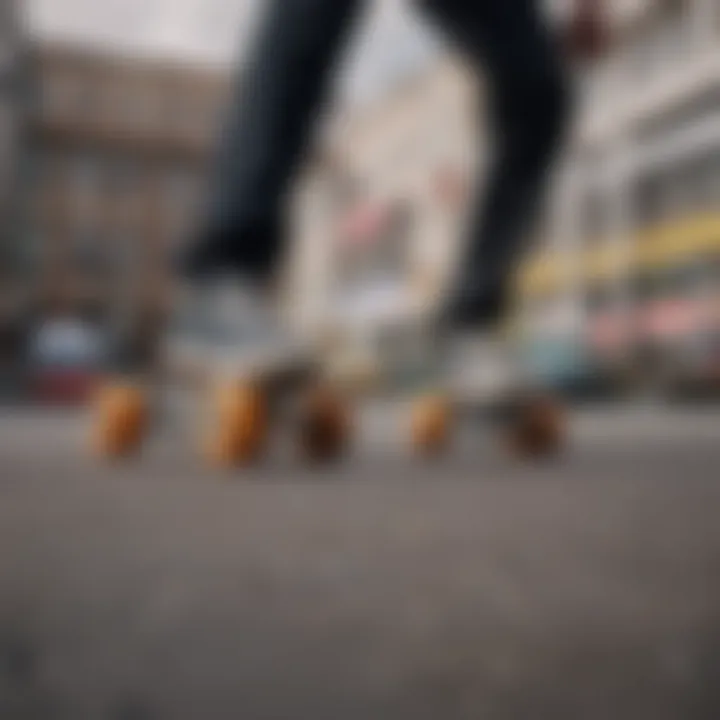
Intro
The world of skateboarding is a vibrant patchwork of styles, techniques, and, of course, gear. Among the key components influencing performance and ride quality in this sport is the skate wheel, and more specifically, the hardness rating, which often swings the spotlight towards the 99a skate wheels. These wheels sit comfortably in the middle ground of hardness, providing a unique blend of grip and resilience, making them a popular choice for various types of skating.
Understanding these wheels requires delving deeper into their composition and how this affects their performance on different surfaces. Whether you're a newbie finding your balance or a seasoned skater looking for that edge, knowing the ins and outs of 99a wheels can make all the difference.
This piece aims to unravel the complexities surrounding 99a skate wheels, providing an in-depth look into their characteristics, advantages, and drawbacks. It serves as a guide for enthusiasts at different skill levels, ensuring that they make informed choices as they embark on their skating journey.
Techniques and Skills
Essential Tricks for Beginners
For those just stepping onto the skateboard, mastering the basics is key. Acquiring the skills to perform simple tricks not only builds confidence but also enhances one’s enjoyment on the board. Here are a few essential tricks that beginners should focus on:
- Ollie: This foundational move involves using the tail of the board to pop it into the air while dragging your back foot up the deck. It’s vital for transitioning to many other tricks.
- Kickflip: Once you’ve got the ollie down, adding a flick of the front foot allows the board to spin beneath you, a move that impresses onlookers and lays the groundwork for advanced tricks.
- Manual: Balancing on the back wheels while keeping the front elevated is a stylish way to show control and set yourself apart.
Advanced Techniques for Pros
For the more experienced skater, pushing the boundaries is what it’s all about. Here are some advanced techniques that can elevate a pro's game:
- Nosegrind: This trick very much demonstrates skill as you grind along an edge while balancing on the front truck of your board.
- 540 Shuvit: A complex maneuver where the board spins 540 degrees while you remain airborne. It demands precision, timing, and a bit of nerve.
- Heelflip Variations: Once proficient with the vanilla heelflip, experimenting with variations can add flair and complexity, catching the eyes of those around you.
Skateboarding is constantly evolving, and learning new tricks can significantly enhance your riding experience. The blend of skill development in both beginner and advanced phases creates a fluid dynamic in the lives of dedicated skateboarders.
Skateboarding Culture
The Evolution of Skateboarding
The journey of skateboarding is a fascinating one. Originating in the late 1940s and early 1950s, it began as a pastime for surfers seeking to mimic their sport on land during flat spells. Over the decades, it morphed into a cultural phenomenon, weaving itself into the fabric of youth culture and rebellion. From the early days of wooden boards with roller skate wheels to today’s high-tech variations, the evolution is a testament to innovation and creativity.
Influential Skateboarders and Their Impact
Skateboarding wouldn’t be what it is today without the pivotal figures who steered its trajectory. Some of these icons not only influenced trends but forever changed how we view the sport:
- Tony Hawk: Often regarded as the ambassador of skateboarding, Hawk’s innovative tricks and media presence helped elevate the sport to mainstream awareness.
- Rodney Mullen: Known as the godfather of street skating, Mullen is credited with inventing many foundational tricks and contributed vastly to what we now recognize as technical skateboarding.
Skate culture thrives on the exchange of ideas and styles, and great skaters continue to inspire the next generation. Their contributions enrich the sport and influence wheel development and performance, including for 99a wheels, as skaters look for durability and performance.
By analyzing these elements, one can better appreciate the significance of choosing the right skate wheels and how they affect one's skating style. This understanding not only enhances the skater's experience but also fosters a deeper connection to the culture around skateboarding.
Intro to Skate Wheels
Skate wheels might seem like an afterthought when considering a skateboard's overall performance, but they play a critical role in how the board feels to the rider. Understanding the intricacies of these wheels can make or break one's skating experience. The right wheel can offer a seamless ride, whether you're cruising at the park or tearing through a street course. Crucially, factors such as speed, grip, and durability hinge on the wheels attached to your board.
Understanding Skate Wheel Polyurethane
When we talk about skate wheels, we can't skip over polyurethane – the magic material that gives these wheels their unique properties. Unlike rubber, which can quickly wear down and lose shape, polyurethane molds easily while maintaining strength. This material allows manufacturers to craft wheels with various hardness levels, making it possible for a skater to tailor their setup according to personal preference and skating style.
The composition of polyurethane also contributes to the wheel's performance. Wheels made with high-quality polyurethane provide better rebound, which translates to enhanced speed and control. Think of it as a well-tuned engine; without quality components, even the best designs will underperform.
"Polyurethane is to skate wheels what good soil is to a garden – it’s foundational."
What Does the Durometer Scale Indicate?
Now, let’s dive into an important aspect – the durometer scale. This scale is the industry standard measure designating the hardness of a wheel. Ranging from 0 to 100A, the numbers tell skaters not just how hard the wheel is, but also help identify the kind of ride they can expect.
For wheels rated at 99A, this number indicates a high level of hardness. Harder wheels often allow for better slides and are preferred in trick skating. They provide a lot of speed on smooth surfaces but might not handle rough terrains quite as well. Conversely, softer wheels, generally around 78A to 88A, offer increased grip and cushion, popular with street skating enthusiasts who tackle varied surfaces.
In this context, the durometer is your trusty guide. Understanding where 99A wheels fit on that scale helps inform not just the setup choices you make, but also the skating experiences you’ll pursue.
In sum, the complexities of skate wheel manufacturing, from material to hardness, hold significant sway over performance. It's a world worth diving into, especially when every small detail can elevate your skating game.
Defining 99a Skate Wheels
Understanding the definition of 99a skate wheels is pivotal in any discussion surrounding them. These wheels are often lauded for their capability to strike a balance between speed and traction, making them a favorite among many skaters. Knowing the nuances of this durometer rating can aid skaters in making informed choices tailored to their personal skating needs.
Composition of 99a Wheels
The composition of 99a wheels is integral to their performance characteristics. Typically, these wheels are crafted from high-quality polyurethane. This material not only ensures durability but also provides an optimal balance of grip and resilience. Meanwhile, the specific manufacturing process can influence the wheels’ overall hardness and performance.
Skaters must pay attention to the process when shopping for wheels. For instance, wheels made with more advanced methods like compression molding may offer consistency and reliability that cheaper alternatives can lack. Quality control is essential here, as a well-made wheel will withstand the tests of time and wear far better than one that isn't.
Another noteworthy aspect is the core of the wheel, which might be made from either plastic or aluminum. Each material has its own benefits; while aluminum cores can provide strength and reduce the risk of breaking under stress, plastic cores can be lighter in weight. The combination of these materials contributes greatly to how a 99a wheel behaves under different skating conditions.
Comparative Hardness of 99a Wheels
When discussing comparative hardness, 99a skate wheels easily rank towards the higher end of the durometer scale. To put it simply, a durometer rating indicates how hard or soft a wheel is on a scale of 0 to 100. A rating of 99a means these wheels are relatively hard, which can be advantageous in various skating environments.
It's interesting to note how harder wheels can offer benefits such as increased speed and less rolling resistance. This can be a game-changer when skating on smooth surfaces like skate parks, where maximizing performance is crucial. However, a caveat exists; the same properties that make 99a wheels fast can contribute to a less forgiving ride on rough terrain. They tend to transmit more vibrations from the ground, which can diminish comfort, especially during longer skating sessions.
In contrast, softer wheels, generally rated at 78a to 88a, excel in providing comfort and grip on uneven surfaces. So selecting a wheel isn't merely about hardness; it's about understanding the type of skating you intend to do.
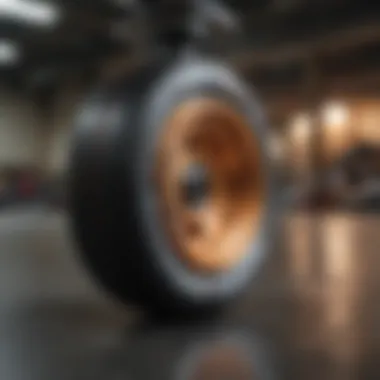
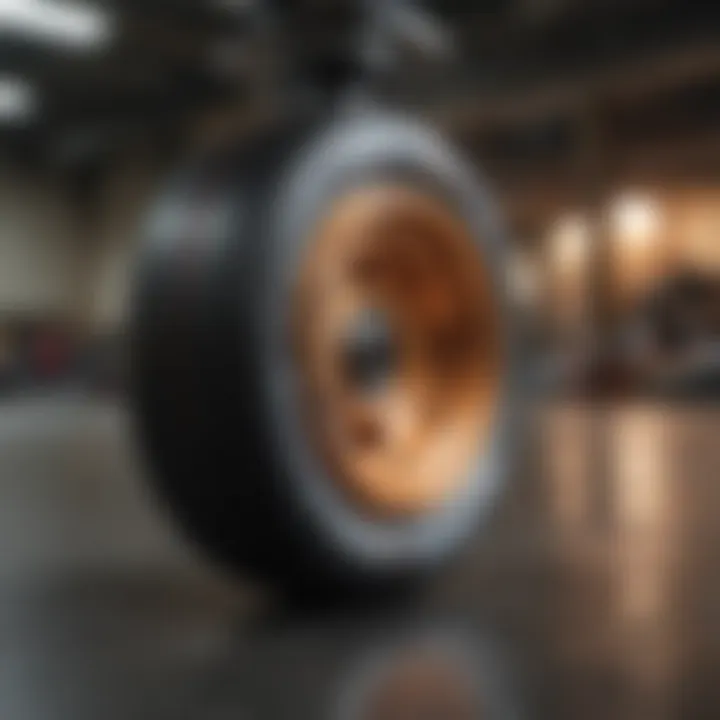
"The combination of hardness and material composition can significantly impact a skater's experience, influencing everything from speed to grip and ultimately affecting performance."
When considering wheel hardness, it’s crucial to think about how personal preference aligns with the intended skating conditions. Many skaters prefer 99a wheels for street skating or park sessions due to the speed, while others may require softer wheels for cruising or more rugged environments. Ultimately, knowing what's beneath your board can directly influence your overall enjoyment and performance on it.
Performance Characteristics
Performance characteristics are pivotal when examining 99a skate wheels as they influence everything from speed to control during skating. For any skater, understanding the nuances of performance can significantly enhance the overall skating experience. 99a wheels sit at a specific place on the hardness scale, allowing for a balance between speed and maneuverability, which merits deeper exploration into the distinct aspects of this specific wheel type.
Speed and Durability Aspects
Speed tends to be the name of the game for most skaters, and this is where 99a wheels shine brightly. Their hardness contributes to reduced rolling resistance which, in layman's terms, means they can glide a heck of a lot more smoothly over surfaces without too much effort. When you're zipping down a street or hitting a ramp, the ability of these wheels to sustain high speeds can be a game-changer.
However, it's not just about going fast. Durability also plays a significant role in performance. 99a wheels are crafted from materials that offer a robust lifespan. When well-cared-for, these wheels are likely to withstand not just the wear and tear of everyday skating but also the occasional rough landing. Perhaps you've seen those skaters who always seem to cruise by without having to change wheels every month. Much of that often boils down to the quality of their gear, and 99a wheels are known for holding up under varied conditions.
"Choosing the right wheels isn’t merely a matter of preference; it’s about optimizing your entire skating setup for the best possible performance."
Sliding and Gripping Dynamics
Moving on to sliding and gripping, this aspect is particularly important for tricks and technical maneuvers. 99a wheels offer a unique blend of grip and slide ability. This duality can be essential when you're performing tricks that require transitions between gripping to sliding and back again. The hardness enables skaters to approach a slide with confidence, knowing that they won’t lose control unexpectedly.
But let's break this down a bit further:
- Grip: When you're tackling sharp turns or need to come to a quick stop, the grip provided by these wheels can be a lifesaver. It allows skaters to maintain their balance and control, especially on transitions or rough spots.
- Slide: On the flip side, for those who fancy their chances with technical tricks like grinds or slides, 99a wheels still do the job nicely. Their hardness permits skaters to slide seamlessly when required but also return to gripping mode without skipping a beat.
These performance characteristics make 99a wheels incredibly adaptable to various skating styles, situational demands, and personal skating preferences. For those engrossed in their craft, understanding these details can lead to not just better performance but also a more enjoyable experience on the board.
Best Use Cases for 99a Wheels
When you're looking to hit the pavement or the park, understanding the best use cases for 99a wheels is crucial. The specific features of these wheels cater to various skating scenarios, thus enhancing performance and enjoyment. This section dives into ideal conditions and the types of skating where 99a wheels shine the most. Knowing when and where to utilize these wheels can profoundly affect the overall skateboarding experience.
Ideal Conditions for 99a Wheels
99a skate wheels are best suited for urban riding, smooth concrete surfaces, and skate parks with well-maintained ramps and transitions. This hardness level provides a solid grip on flat terrains while allowing for a higher speed performance. When skating on boards with 99a wheels, keep an eye out for the following conditions:
- Smooth Surfaces: These wheels excel on polished pavement. If you're cruising around city streets with minimal cracks, the ride should be enjoyable.
- Dry Weather: Rain and wet surfaces aren’t buddies with 99a wheels. Under damp conditions, you may experience a lack of grip, which can lead to slips.
- Indoor Facilities: Skate parks often provide those perfect conditions with smooth flooring. Ideal for practicing tricks without worrying about surface imperfections.
Ultimately, the material and construction of 99a wheels allow for a balance between speed and stability when the environment is right. Without these ideal conditions, the performance can falter, making their specific usage vital to comprehend.
Recommended Skating Styles
For skaters considering whether 99a wheels suit their style, it’s essential to categorize them accordingly. Here's where the 99a wheels really show what they can do:
- Street Skating: They provide superior control for balancing tricks on ledges, stairs, and rails. The hardness helps achieve precision while also enabling quick transitions between tricks.
- Vert and Transition: If you're hitting ramps, a solid set of 99a wheels can help maintain speed and stability while executing aerial maneuvers.
- Cruising and Commuting: While not primarily aimed at this style, skaters can still enjoy a ride on smooth pavements. Just keep in mind the need for speed and agility over comfort.
"Choosing the right wheel can be the difference between a good day of skating and a frustrating one. Be wise with your choices."
Advantages of 99a Skate Wheels
In the vast universe of skateboarding, the choice of skateboard wheels can significantly affect performance and skating experience. Among the myriad of options, 99a skate wheels stand out for their unique characteristics that cater to specific needs of skaters. This section sheds light on the benefits these wheels offer, emphasizing points vital to both beginners and seasoned pros alike.
Enhanced Control during Tricks
Control is key in skateboarding, particularly when performing tricks. 99a wheels are known for their hardness, which provides a firm contact with the surface. This results in precise movements, making it easier to land tricks reliably.
- Stability: The hardness contributes to a stable performance during kicker jumps and grinds. If you're attempting an Ollie or a flip trick, knowing that the wheels will grip the surface securely can boost your confidence.
- Feedback: Skaters often mention the tactile sensation they receive from 99a wheels. The feedback helps to better understand what's happening underneath the board. This awareness is crucial, especially when attempting technical maneuvers.
- Power Transfers: When you push off, the responsiveness of these wheels aids in clear, potent power transfers. Doing a trick with confidence often results from knowing your equipment will perform reliably, and 99a wheels deliver on that.
With the inherent grip that comes from 99a stiffness, skaters can hone their techniques and elevate their game.
Resilience and Longevity
Another strong point in favor of 99a wheels is their resilience. Made with dense polyurethane, these wheels are designed to face tough conditions typical in skateboarding. The longevity factor becomes crucial for aspiring skaters who want to make the most out of their investment.
- Durability: Unlike softer wheels, which might wear down quickly when subjected to rough surfaces, 99a wheels maintain their integrity longer. They resist flat spots and maintain performance, ensuring longer periods between replacements.
- Cost-Effectiveness: While the upfront cost might be a tad higher compared to softer options, the durability factor means skaters won’t be replacing them as often. Over time, this can translate to significant savings, especially for those who skate daily.
- Consistent Performance: Even with prolonged use, the performance remains consistent. Skaters can rely on these wheels in various conditions, whether it's at a park or on city streets, without losing the feel.
It's clear that 99a wheels not only enhance control but also bring a level of durability that supports the growth of a skater's skills, making them a preferred choice for those serious about their craft.
In sum, the advantages of 99a skate wheels speak to both the practical and experiential aspects of skating, making them worthy consideration for anyone looking to invest in their gear.
Limitations of 99a Skate Wheels
When discussing skate wheels, it's vital to address the limitations of 99a wheels. While they are favored for their performance, particularly in tricks and stunts, they come with certain drawbacks that every skater should consider. Understanding these limitations helps skaters make informed choices tailored to their unique needs and environments.
Potential for Reduced Comfort
One of the primary concerns regarding 99a wheels is their comfort level. The hardness associated with a durometer rating of 99a can translate into a harsher ride on rough surfaces.
- Vibration: When cruising over uneven pavement, skaters often experience increased vibrations that can lead to discomfort. This can be particularly challenging for those who are not used to the rigid feel of harder wheels. While seasoned skaters might brush it off, a newcomer may find it unsettling.
- Foot Fatigue: With reduced shock absorption, longer sessions can lead to foot fatigue. This is especially true for skaters who spend substantial time practicing tricks or commuting on their boards. Even though they provide excellent response and control, the trade-off can be significant regarding long-term comfort.
"Skating on 99a wheels can feel like a wild ride on a bumpy road. You can't escape the vibrations, and your feet will remind you!"
Incompatibility with Certain Environments
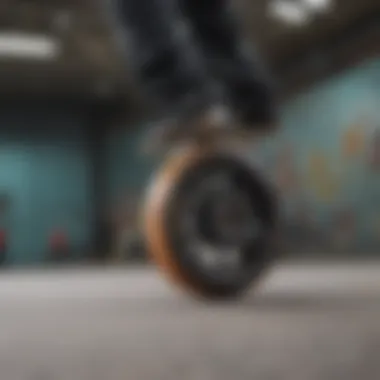
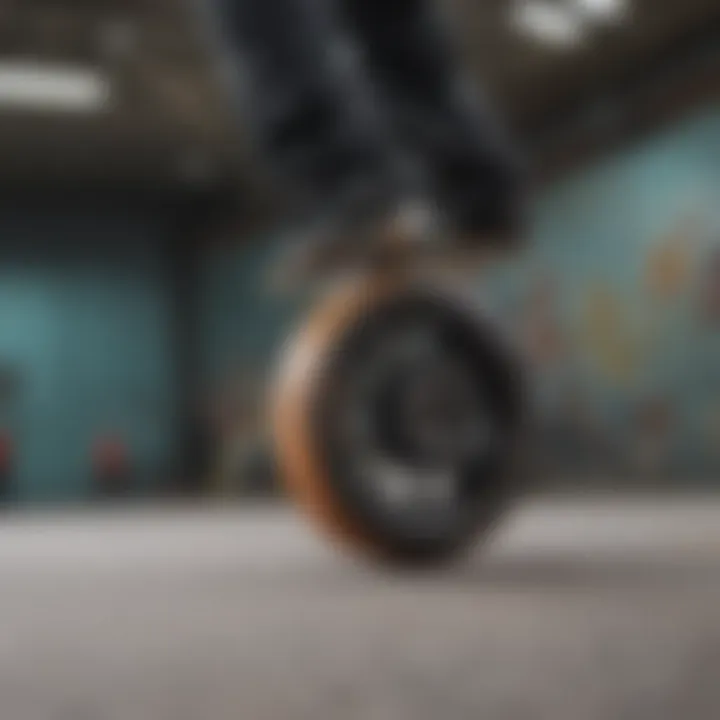
99a wheels shine on smooth surfaces but may not be ideal for all conditions. Their performance can falter in specific environments, creating challenges for skaters.
- Rough Terrain: Skating on coarse asphalt or uneven terrain can be a tough pill to swallow for these wheels. The hardness, while providing speed on slick surfaces, results in a less-than-stellar performance on gravel or cracked streets. In these situations, softer wheels might be a better choice.
- Indoor Parks: Many indoor skate parks are designed with specific wheel hardness in mind. Some parks may emphasize smoother rides, meaning that utilizing 99a wheels might not yield the traction and control that softer alternatives would provide.
When planning a session, it’s worth considering the surface to avoid frustration and ensure optimal performance.
In review, while 99a wheels offer unique advantages, being aware of their limitations can enhance the skating experience, especially for those experimenting with various surfaces and styles.
Skateboard Setup Considerations
When venturing into the realm of skateboarding, the setup of your board plays a pivotal role in your overall skating experience. Focusing on the skateboard setup is not merely a mechanical chore; it encompasses understanding how each component interacts for optimal performance and comfort. Particularly if you are using 99a skate wheels, recognizing how they fit into your larger setup is essential.
One of the principal elements to ponder is wheel size. The diameter of your wheels affects not only the speed you can achieve but also how your board feels when rolling over various surfaces. Bigger wheels tend to offer a smoother ride, making them preferable for cruising, while smaller wheels can facilitate more technical tricks. Hence, it is important to find a balance that aligns with your skating style.
The wheel size should interface with your board's width and overall design, granting coherence in your setup.
In addition to wheel size, the hardness of the wheels, such as the 99a durometer, must synergize well with the rest of the components. A hard wheel will provide excellent grip on smooth surfaces and maintain momentum, making it ideal for street skating or parks. Conversely, pairing them with a softer material in the bearings and trucks can sometimes yield a mismatch in performance and feel.
Wheel Size Recommendations
Choosing the correct wheel size is like fitting a round peg into a round hole – it ought to be snug. Standard wheel sizes range from 50mm to 60mm, and the choice largely depends on your skating style.
- 50-52mm: Best suited for technical street skating, where agility and control are crucial.
- 53-55mm: A more versatile option that can work well across street and park environments.
- 56-60mm: Good for cruising and park riding, offering stability on rougher surfaces.
It's wise to experiment with different sizes during practice. Aligning your choice with the type of terrain you frequent can significantly enhance your performance.
Matching with Other Components
Creating harmony among the parts of your skateboard enhances the overall skating experience. 99a wheels will perform best when matched with compatible components that keep the ride smooth and responsive. This includes the trucks and bearings.
- Trucks: Your truck width should match your board’s width, allowing for proper turning and balance. For instance, if you're using wider decks, opt for wider trucks for stability.
- Bearings: While the wheels drive the performance, bearings contribute silently to the overall setup. Choose high-quality bearings to take full advantage of the speed provided by those firm 99a wheels.
When all elements within the setup sync harmoniously, you lessen friction points and amplify the joy of skating. So, if you find that your 99a wheels are not performing as you anticipated, take a moment to assess how well they mesh with the rest of your board.
Understanding these fundamentals can greatly impact your choices, ensuring that every ride feels just right. A skater's setup is often a reflection of their individual style and needs, making it crucial to fine-tune each element until everything falls into place.
Skating Techniques Involving 99a Wheels
Understanding how to maneuver on 99a skate wheels can significantly enhance one's skating experience. These wheels cater to a variety of styles, making them a versatile choice for skaters of varied skill levels. The significance of skating techniques lies in their ability to optimize performance and safety while improving proficiency on the board. When skaters grasp the characteristics unique to 99a wheels, they can execute tricks and maneuvers with greater efficiency and confidence.
Fundamental Tricks
Mastering the fundamental tricks is crucial for any skater looking to improve. Tricks like the ollie, kickflip, and shove-it serve as the foundation for more complex maneuvers. When using 99a wheels, these tricks come with distinct advantages, owing to the reliability and grip offered by the wheels’ hardness.
Here are some tips for executing basic tricks on 99a wheels:
- Ollies: Ensure your weight shifts properly as you press down on the tail of the board. The stiffer 99a wheels help to maintain balance on hard surfaces, essential for a good landing.
- Kickflips: When flicking, the wheel's hardness allows for a precise control of your board, facilitating a cleaner flip.
- Shove-its: The robust nature of 99a wheels provides a solid surface grip, allowing you to spin the board beneath you without worrying about losing control.
Taking the time to practice these tricks can drastically improve your skateboarding foundations.
Advanced Maneuvering Strategies
Once the fundamental tricks are in place, moving on to advanced techniques can further expand your repertoire. These skills require fine-tuning of timing, balance, and the intricate relationship between the board and your movements. Here’s where 99a wheels can shine, thanks to their balance of grip and speed.
Consider the following strategies:
- 360 Shuvits: The added hardness of 99a wheels permits quicker rotation during complex spins, crucial for achieving this trick.
- Grinds and Slides: The slide-ability provided by 99a wheels complements the precision needed for various grind tricks. Finding a smooth ledge or rail can allow you to smoothly execute these tricks without worrying about your wheels catching.
- Transition Techniques: If you venture into ramps or bowls, the performant nature on transitions becomes apparent. The steady characteristics of 99a wheels support deeper carves and more controlled slides while maintaining speed. When transitioning, focus on shifting your weight appropriately, so you can leverage the wheels' capabilities.
In summary, knowing which techniques work best with 99a wheels can elevate your skating skills. The foundation laid by fundamental tricks can seamlessly build into advanced maneuvering concepts.
"The connection between wheels, tricks, and skill cannot be overstated; mastering this trio paves the way for true progress in skateboarding."
By continuously developing both fundamental and advanced skills on 99a wheels, skaters not only sharpen their techniques but deepen their overall enjoyment of the sport.
Maintenance and Care of Skate Wheels
Maintaining and caring for skate wheels is crucial for any skateboarder looking to maximize performance and longevity. 99a wheels, with their specific hardness and composition, necessitate routine checks and cleaning to ensure they function optimally. This section delves into the essential aspects of keeping these wheels in prime condition, highlighting why this topic deserves serious attention.
Regular Inspection and Cleaning
Routine inspection and cleaning of your skate wheels can extend their lifespan significantly. Skaters often overlook this simple upkeep, leading to premature wear or unexpected failures during use. Here are several considerations and practices for effective maintenance:
- Inspection Frequency: Aim to check your wheels after every few skating sessions. Look for dirt buildup, chips, or cracks that might affect performance.
- Cleaning Methodology: Use mild soap and warm water to clean the wheels. A soft brush can help remove debris from hard-to-reach spots. Avoid strong chemicals, as they may damage the polyurethane material.
- Bearing Maintenance: Don’t forget to clean the bearings. Take them out, lubricate them properly, and then reinstall. This enhances the wheel’s rotation and contributes to smoother rides.
"A clean wheel rolls better and lasts longer; neglect leads to mess and stress on your ride."
Establishing a cleaning routine can make a significant difference. Consider setting aside a few minutes every week for checking and cleaning your wheels. This not only preserves the wheels but also improves your overall skateboarding experience.
Signs of Wear and Tear
All things wear down over time, and skate wheels are no exception. Recognizing the signs of wear and tear early on can prevent further damage and improve your skating safety. Here are some signs to watch for:
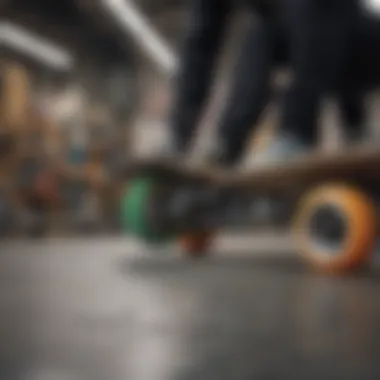
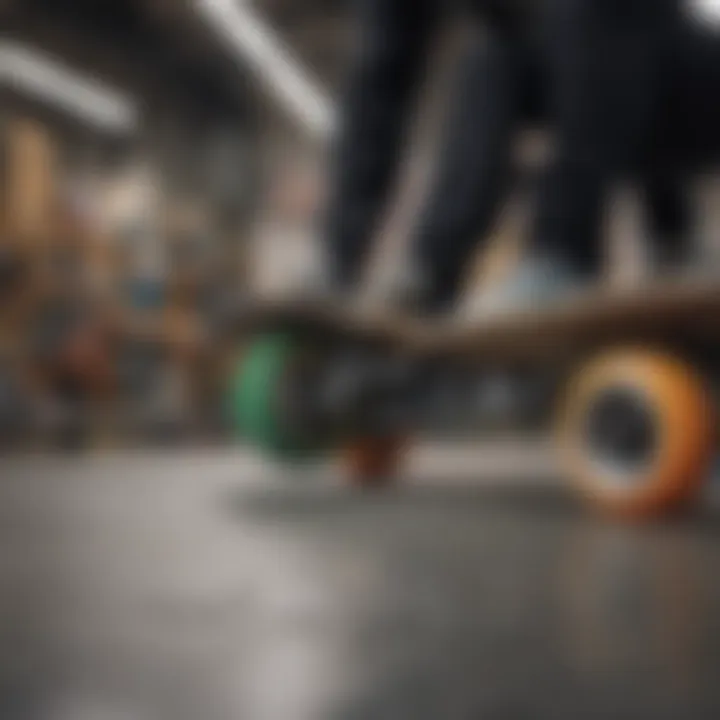
- Flat Spots: If you notice any flat areas on the wheels, it’s a clear indicator that they are losing their roundness and can affect your performance.
- Cracks or Chips: Any visible damage can compromise the structural integrity of the wheel. Even small cracks can worsen quickly if not addressed.
- Uneven Wear: Look for signs of unevenness in wheel surface; it often results from poor alignment or overuse.
- Reduced Grip: If it feels like your wheels aren’t grabbing the surface as they used to, it might be time for a replacement; worn wheels can lead to compromised control during tricks.
Monitoring these signs allows you to determine when it’s best to replace your wheels before it can negatively impact your skating.
Maintaining 99a wheels may seem tedious, but it's a small price to pay for the benefits of improved performance and safety. Skaters should always prioritize maintenance to ensure captivating rides and reduce frustrations down the road.
Exploring Alternative Wheel Options
In the realm of skateboarding, selecting the right equipment can greatly influence performance, style, and safety. While 99a wheels are a staple choice for many skaters, there’s a rich variety of alternative wheel options that promise different experiences on the board. Understanding these choices is essential for those looking to refine their skating style or adapt to various terrains. Whether for street skating, ramp riding, or even cruising, the options available can cater to different needs and preferences.
Comparing with Softer Wheels
Softer wheels, often characterized by a durometer rating below 99a, present a number of advantages and disadvantages when placed next to their harder counterparts. Typically, these wheels are made from a softer polyurethane material, which tends to allow for increased grip and shock absorption. This makes them particularly appealing for skaters who frequent rougher terrains or prioritize comfort during their rides.
- Enhanced grip: Softer wheels often provide better traction on uneven surfaces, allowing for smoother navigation.
- Shock absorption: The pliable nature of softer wheels reduces impact, which can be crucial for skaters who perform tricks that involve jumping or landing.
- Increased comfort: For long sessions, softer wheels help minimize fatigue by absorbing vibrations.
However, one must also consider that softer wheels tend to wear down more quickly than harder ones. Over time, they can become less effective in providing the same performance benefits. For someone advanced in skating, there may be a noticeable difference in speed and responsiveness when transitioning from 99a wheels to softer variants. Thus, while these wheels might enhance some aspects of control and enjoyment, they may compromise performance and durability in others.
Exploring Harder Durometers
On the flip side, those skaters seeking increased speed and responsiveness may lean toward wheels rated above 99a in hardness. These harder durometers offer unique advantages, especially in specific skating situations. Harder wheels are designed to maintain shape and speed, which makes them suitable for smooth, flat surfaces, such as skate parks or well-paved streets.
Some notable features include:
- Less rolling resistance: Harder wheels tend to glide more effortlessly over surfaces, allowing for quicker speeds.
- Increased durability: These wheels are often more resilient against chipping and deformation, helping to maintain their performance for a longer time.
- Precision control: Greater hardness enhances the feedback skaters receive, allowing for more accurate movements while performing tricks.
While the allure of these wheels is evident, it is important to acknowledge their limitations. Harder wheels can feel unforgiving on rough terrain and can be slippery on certain surfaces, which may pose challenges for beginners who are still developing their skills.
The choice of wheel hardness directly impacts performance, comfort, and skating style. It is crucial to evaluate your skating environment and personal preferences when selecting from various wheel options.
In summary, exploring alternatives to 99a wheels opens the door to a wide range of skating experiences. From softer wheels that provide comfort and grip to harder options that promote speed and durability, each type serves its purpose depending on the skater’s goals and environment. Making informed choices starts with an understanding of what these different options offer.
Purchasing Considerations
When it comes to investing in 99a skate wheels, having a keen understanding of your purchasing options is crucial. This decision is not simply about picking a product off a shelf; it involves factors like performance, durability, and even how they fit into your overall skating style. With a sea of options available, it's essential to navigate through the noise to make an informed choice.
Selection also varies based on skill level, the type of skating you engage in, and personal preferences. For instance, if you’re a street skater, you might prioritize maneuverability and durability. On the other hand, transition skaters may lean towards wheels that offer smooth rolling and grip.
Where to Buy Quality 99a Wheels
Acquiring quality 99a wheels can feel a bit like searching for a needle in a haystack, especially with the plethora of online and physical stores at your disposal. Here are some reliable avenues:
- Specialized Skate Shops: These are often the most reliable source. They usually carry a range of wheels and provide knowledgeable staff to help you make the right choice. Plus, you can often feel the wheels firsthand and ask burning questions about their performance.
- Online Retailers: Websites like Amazon or Skate Warehouse offer a broad selection and customer reviews that can aid your decision. Just be wary of third-party sellers and check ratings to ensure quality.
- Direct from Manufacturers: Buying directly from brands like Ricta or Spitfire can provide peace of mind in terms of authenticity. Brands often share detailed specs about their wheels, which can be beneficial in making an informed decision.
- Local Classifieds and Resale Boards: Sometimes, skaters sell used wheels in good condition at a fraction of the price. Just ensure you check for signs of wear and ask about their skating history to avoid any pitfalls.
"When we buy skate gear, we’re not just throwing our money away. We’re investing in the joy of skating. Choose wisely."
Evaluating Quality and Price
The balance between quality and price is pivotal. Skaters don’t want to throw money into a bottomless pit but, at the same time, they can't skimp on quality. Here's what to keep in mind:
- Material Composition: Quality wheels are usually made of high-grade polyurethane. Cheaper options may use lower quality materials, leading to quicker wear.
- Manufacturer Reputation: Brands that emphasize innovation and quality assurance often have higher prices, but their products tend to perform better and last longer.
- Buyer Reviews: Opinions from fellow skaters can be invaluable. Look for reviews that highlight performance under specific conditions. They can reveal real-world insights that product descriptions often gloss over.
- Warranty or Return Policy: A good warranty can indicate a manufacturer’s confidence in their product. Also, ensure the return policy is favorable in case the wheels don't meet your expectations.
- Comparative Price: Before jumping in, do a quick comparison across different platforms. Prices can vary significantly. Sometimes they offer discounts or bundles that offer better value for your money.
Finding that sweet spot between cost and performance allows skaters to maximize both enjoyment and longevity with their 99a wheels.
Influence of Skateboarding Culture on Wheel Preferences
Skateboarding isn't merely a sport; it's a cultural phenomenon that stretches back to the 1950s and 60s. The ethos, lifestyle, and preferences built around skating influence not only the tricks executed but also the gear skateboarders select, specifically wheels like the 99a. Understanding how skateboarding culture shapes wheel preferences is pivotal in grasping the broader framework of skate gear. The way skaters resonate with particular wheels can impact their performance and overall enjoyment.
Trend Analysis Over the Years
Trends in skateboarding culture have shifted the way wheel hardness is perceived and utilized. Back in the day, softer wheels were favored for their ability to absorb shocks and offer a smoother ride on rough surfaces. But as skating evolved, so did the emphasis on control and precision, which brought harder wheels, such as the 99a rating, into the limelight. Here's how the trends have unfolded:
- 1970s - 1980s: Skaters relied heavily on softer wheels for cruising and outdoor skating.
- 1990s: The emergence of street skating paved the way for harder wheels. Skaters needed greater control for tricks in urban environments. Choices shifted towards 99a and harder wheels.
- 2000s and beyond: Styles and subcultures further diversified, leading to greater acceptance of various hardnesses, yet 99a remained a staple among street skaters for tricks due to its enhanced grip and responsiveness.
This transition mirrors the skateboarding culture's evolution from leisurely rides to high-stakes performances, showcasing an ingrained preference for gear that empowers skaters to express their skills more effectively.
Cultural Impact on Skater Choices
The 99a skate wheels' rise isn’t just about performance; it intertwines deeply with social identity and community. In the world of skateboarding, what wheels one chooses can tell a lot about their skating style and, to some extent, their personality. This aspect creates a rich tapestry of cultural significance:
- Community Influence: Skaters are often swayed by local skating heroes. If a local legend swears by 99a wheels, it's almost certain that newcomers will follow suit, either for cohesion or aspiration.
- Social Media and Representation: With platforms like Instagram and TikTok, sharing skate videos has fostered trends quickly. A popular skater using 99a wheels can prompt a surge in their popularity as others aspire to mimic their success.
- Cultural Narratives: Certain wheels become symbols in skate documentaries or videos, attaching a narrative to them. They often serve as a bridge connecting enthusiasts to the history and tribulations of skate culture.
The interplay between cultural elements and the technical aspects of skateboarding not only shapes gear preferences but also fortifies the sense of community and belonging among skaters. The choice of wheels becomes a subtle nod to identity and shared experience, adding yet another layer to the rich heritage of skating.
Finale and Recommendations
When it comes to skateboarding gear, choosing the right wheels can make or break the experience. In this article, we’ve delved into the nitty-gritty of 99a skate wheels. The significance of this topic can't be understated, especially for skaters looking to elevate their performance or simply enjoy the ride.
Final Thoughts on 99a Wheels
99a skate wheels often merge durability with performance. They strike a balance that appeals to both beginners and advanced skaters alike. The hardness of 99a allows for greater speed while maintaining stability, a must for executing those gravity-defying tricks. A skater might feel the differences immediately, like trading in a trusty old car for a sports model. The transition is palpable. Yet, comfort can sometimes take a hit, especially when navigating rough patches or uneven surfaces. If you're considering these wheels, it's wise to weigh their advantages against personal comfort levels.
"Choosing the right skateboard wheels is like picking the shoes for a marathon; you've got to know what works for you."
Where to Go from Here
For those who have read through this entire analysis and feel inspired, the next step is clear—experiment and find what suits your riding style the best. It might mean visiting a local shop that offers a variety of 99a wheels or searching online from trusted sites that provide detailed specs and reviews. Connect with fellow skaters, join forums like those found on Reddit, and don't shy away from asking questions about their experiences. A community is invaluable in the quest for the perfect wheel choice. In the end, it's all about enjoying the ride while being equipped with knowledge that helps you make informed decisions.







